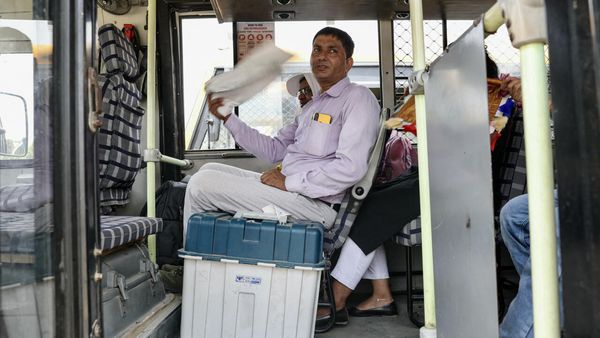The Indo-Pacific Maritime Domain Awareness (IPMDA) initiative, announced by the Quad grouping, is a testament to our commitment to a free, open, inclusive and rules-based Indo-Pacific, Navy Chief Admiral R. Hari Kumar said, stressing that building networks and partnerships would be instrumental in ensuring the security and stability of the Indian Ocean Region (IOR). On force modernisation, he said they were on track to be a 170 to 180 ships and submarines Navy by 2028.
“This initiative [IPMDA] seeks to establish a comprehensive system for monitoring and securing maritime activities in the Indo-Pacific, ensuring the safety of critical sea lines of communication, and promoting cooperation among like-minded nations in the region,” Admiral Hari Kumar said in a conversation with The Hindu on the sidelines of the 4th Goa Maritime Conclave (GMC) held from October 29 to 31 in Panaji. “We understand the significance of this region for global peace and prosperity, and we are dedicated to working with our Quad partners and other regional nations to make the Indo-Pacific a safer and more stable place for all.”
Also Read | Quad is a ‘force for good’, says PM Modi
He termed the initiative a significant endeavour aimed at enhancing the security and stability of the Indo-Pacific region, which holds a central place in global geopolitics. The IPMDA was announced by the Quad grouping, comprising India, Australia, Japan and U.S., at the Tokyo summit in early 2022 to track “dark shipping” and build a “faster, wider, and more accurate maritime picture of near-real-time activities in partners’ waters”, integrating three critical regions in the Indo-Pacific — the Pacific Islands, Southeast Asia, and the IOR.
The Navy currently has over 140 ships and submarines and is targeting a 170 to 180 Navy by 2028. “Sixty-six out of 68 ships under construction are being built at Indian shipyards. Further, 24 ships under contract conclusion will similarly be indigenous — our aim is for the Navy to be fully Aatmanirbhar by 2047,” Admiral Kumar said.
Need for readiness
To a question on lessons from recent events from the stand-off with China in eastern Ladakh, the conflicts in Ukraine and now in West Asia, Admiral Kumar said these events serve as a stark reminder of the need for resilience and readiness. “One more important lesson that we have learnt is the importance of integrated joint operations and a holistic approach to national defence, underlining the need for a well-coordinated defence strategy that encompasses all the three Services,” he said.
These crises have also highlighted the importance of maintaining a credible and versatile naval force that can secure our maritime interests, including energy and trade routes, as well as supply chain vulnerabilities, he stated.
Also Read | Twin hurdles hinder India’s maritime role
On the biennial GMC which saw participation of 12 countries in the region, Admiral Kumar said it had emerged as a critical platform for fostering cooperation and addressing maritime security challenges in the IOR. He said the collaborative effort led to coordinated efforts among the Navies in the region in responding to natural disasters, conducting joint exercises, and sharing critical maritime information.
Establishment of robust mechanisms for information sharing, such as through the Indian Navy’s Information Fusion Centre for Indian Ocean Region (IFC-IOR) located at Gurugram, had greatly improved the situational awareness in the region. The IFC would play a pivotal role in the IPMDA.
Intelligence sharing
Navies had been able to respond more effectively to maritime threats, piracy, and other security concerns, he stated. “Sharing of intelligence and information also contributed to enhanced Maritime Domain Awareness [MDA]. This has not only improved maritime security but also allowed for better management of marine resources and environmental protection.”
The GMC would continue to be a cornerstone in maintaining regional stability by promoting cooperation and adherence to international norms, Admiral Kumar said. “We can anticipate an increased focus on capacity building and technology transfer to ensure all nations have the means to safeguard their maritime interests.”
On the outlook for IFC-IOR, Admiral Kumar said the centre would continue to strengthen its efforts in enhancing MDA which involved the collection, fusion, and dissemination of information critical to the safety and security of the IOR. “The centre will work to further develop its capabilities to provide a comprehensive and real-time maritime situational picture.”
Also Read | Cooperation in Indo-Pacific is in interests of India and Vietnam: Jaishankar
Further, he said the centre would actively seek to establish and strengthen collaborative partnerships with like-minded nations and organisations. “These partnerships will involve sharing best practices, conducting joint exercises, and fostering a sense of collective responsibility,” the Navy Chief added.
India has, in recent years, significantly expanded its bilateral and multilateral engagements in the region, especially with the Quad countries.







